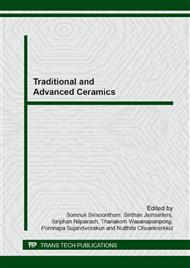[1]
T. Ikeda, A few quaternary systems of perovskite type A2+B4+O3 solid solution, J. Phys. Soc. Jpn. 14 (1959) 286-294.
Google Scholar
[2]
S. Banerjee, N.S. Raj, Processing and polarization behaviour of Sr- containing lead zirconate titanate, Ferroelectrics. 211 (1998) 89-110.
DOI: 10.1080/00150199808232336
Google Scholar
[3]
K.P. Rema, V. Kumar, Structure-property relationship in Mn-doped (Pb0. 94 Sr0. 06 )(Zr0. 53Ti0. 47)O3, J. Am. Ceram. Soc. 91 (2008) 164-168.
DOI: 10.1111/j.1551-2916.2007.02091.x
Google Scholar
[4]
B. Jaffe, Jr. Cook, H. Jaffe, Solid solution of Pb(Ti, Zr, Sn, Hf)O3, Piezoelectrci ceramics (chapter 7), Academic Press, New York , 1971 pp.146-149.
DOI: 10.1016/b978-0-12-379550-2.50011-9
Google Scholar
[5]
Y. Yongjian, T. Jinbiao, N.S. Raj, Phase stability and ferroelectric properties of lead strontium zirconate titanate cceramics, J. Am. Ceram. Soc. 84.
Google Scholar
[2]
(2001) 333-340.
Google Scholar
[6]
M. Takahashi, Space charge effect in lead zirconate titanante ceramics caused by the addition of impurities, Jpn. J. Appl. Phys. 9 (1970) 1236-1246.
DOI: 10.1143/jjap.9.1236
Google Scholar
[7]
K. Hase, M. Saitoh, T. Kittaka, K. Tomono, Electrical and mechanical properties of Pb(Zr, Ti)O3 ceramics related to Mn ion diffusion, Jpn. J. Appl. Phys. 32 (1993) 4227-4229.
DOI: 10.1143/jjap.32.4227
Google Scholar
[8]
X.H. Lian, L. Cheng, Effect of addition of MnO on piezoeletric properties of lead zirconate titanate, J. Mater. Sci. 35 (2000) 2477-2480.
Google Scholar
[9]
P. Zheng, P.L. Zhang, H.B. Qin, K.X. Song, J. Wu, Z.H. Ying, L. Zheng, J.X. Deng, MnO2-modified Ba(Ti, Zr)O3 ceramics with high Qm and good thermal stability, J. Electron. Mater. 42 (2013) 1154-1157.
DOI: 10.1007/s11664-013-2543-x
Google Scholar
[10]
L. Sung, L. Seung, Y. Chang, K. Hyoung, L. Kyung, Low temperature sintering of MnO2-doped PZT-PZN piezoelectric ceramics, J. Electroceramics. 18 (2007) 311-315.
DOI: 10.1007/s10832-007-9174-7
Google Scholar
[11]
A. Ngamjarurojana, S. Ananta, Effect of MnO2 addition on dielectric, piezoelectric and ferroelectric properties of 0. 2PB(Zn1/3Nb2/3)O3-0. 8Pb(Zr1/2 Ti1/2)O3 ceramics, Chiang Mai J. Sci. 36 (2009) 59-68.
DOI: 10.1016/j.ceramint.2007.10.036
Google Scholar
[12]
A. Ngamjarurojana, L. Srisombat, R. Yimnirun, S. Ananta, Extended X-ray absorption fine structure and X-ray diffraction studies of Mn-doped PZN-PZT ceramics, Ferroelectrics. 405 (2010) 50-56.
DOI: 10.1080/00150193.2010.482888
Google Scholar
[13]
K. L. adav, P. Sharma, Synthesis and characterization of Mn doped PZT ceramics, Indian J. Eng. Mater. Sci. 15 (2008) 61-67.
Google Scholar
[14]
S. Takahashi, M. Takahashi, Effect of impurities on the mechanical quality factor of lead zirconate titanate ceramics, Jpn. J. Appl. Phys. 11 (1972) 31-35.
DOI: 10.1143/jjap.11.31
Google Scholar


